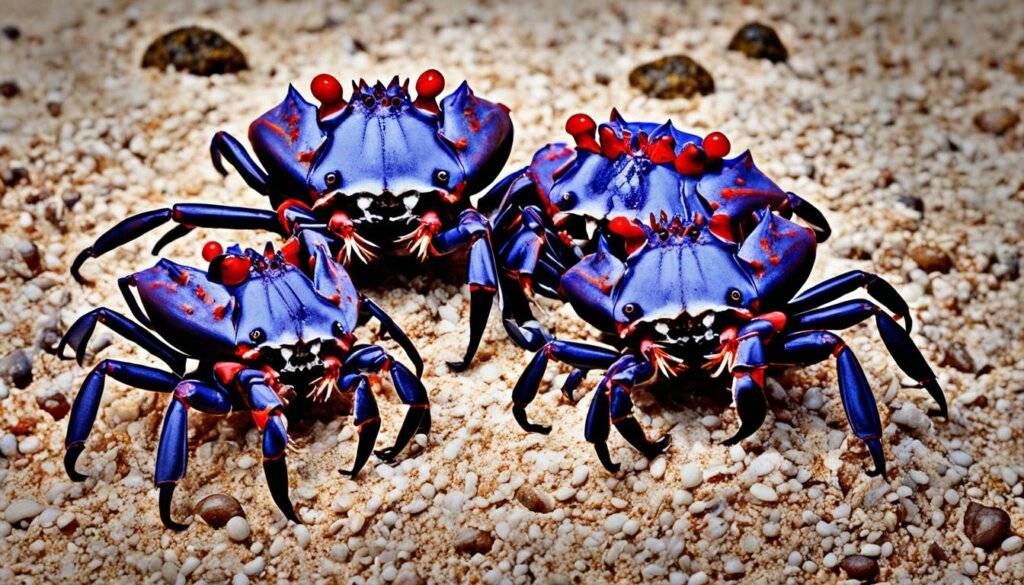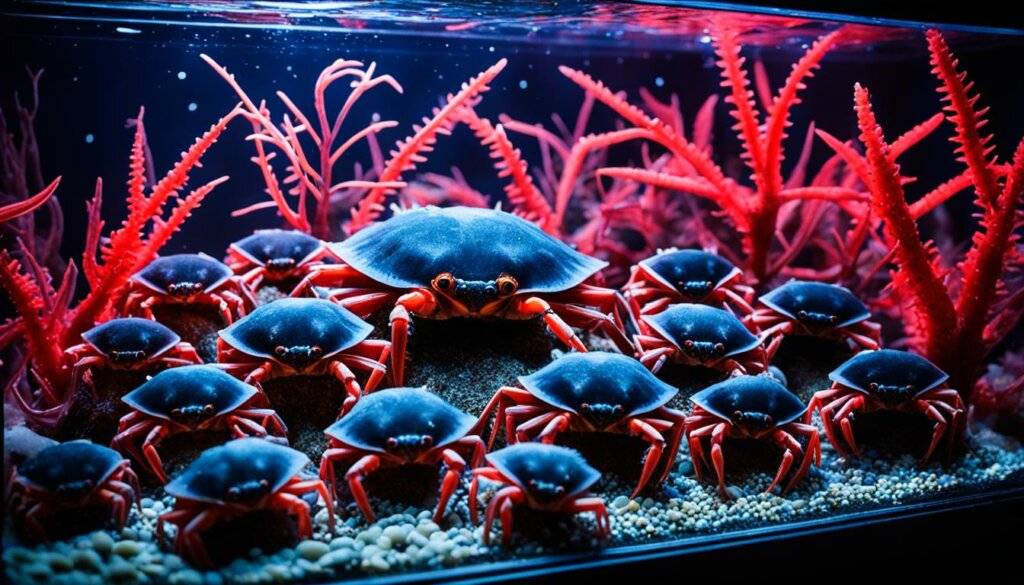If you love terrariums, vampire crabs might catch your eye. These eye-catching freshwater crabs are part of the Geosesarma family. They’re known for their bright colors. Hobbyists and scientists alike find these animals fascinating. There’s always something new to learn about them.
Vampire crabs are more than just pretty. They have unique habits and need special care when kept as pets. They thrive both in homes and their natural Southeast Asian habitats. These creatures are a wonder, delighting crab fans worldwide.
Key Takeaways:
- Vampire crabs are a spellbinding addition to the world of exotic pets, inviting you into a realm of discovery.
- Their vibrant colors and Geosesarma species classification make them standout specimens among freshwater crustaceans.
- For terrarium enthusiasts, these crabs represent a blend of aesthetic appeal and the joy of meticulous care.
- Their growing popularity underscores the importance of understanding both their allure and their ecological needs.
- Embracing the mystery that shrouds vampire crabs is part of the enthralling journey you embark upon as a committed hobbyist.
Introduction to the Enigmatic World of Vampire Crabs
Explore the realm of enigmatic creatures where strikingly colorful crabs rule – welcome to vampire crabs’ world. Enter their domain and see their unique features. Bright yellow eyes and dark shells make them look like from a gothic tale.
Vampire crabs live in a special place, mainly on Southeast Asian islands. Their home is filled with green plants and streams. It’s perfect for their diverse lifestyles. This environment helps them thrive and attracts many fans worldwide.
Even though they’re new to being pets, people love them a lot. Strikingly colorful crabs have quickly become popular pets. Their mysterious look and beauty have won many hearts.
Origin and Distribution: How Vampire Crabs Conquered the Pet Trade
Vampire crabs are unique creatures, hailing from Southeast Asia. They have captivated people worldwide, far beyond their natural habitats. These crabs, from lush freshwater places, have a fascinating story that spans across oceans, leading to their popularity in the pet world. Knowing where they come from helps us understand their needs and the care they require from pet owners.
Natural Habitat and Geographic Spread
The tropical islands of Java and Sumatra are rich in animal and plant life. They are the original home of vampire crabs. These crabs have adapted to a wet climate and areas that mix land and water. Exploring their natural homes helps us see the complex web of life they’re a part of, along with many other species.
Vampire Crabs in the Aquarium Hobby
Vampire crabs are both beautiful and uncommon, winning the hearts of those who like exotic pets. Their growing fame has increased their demand among aquarium enthusiasts. It’s important for pet owners to collect them responsibly. They should also create proper living spaces in their terrariums. This helps protect the crabs in the wild and ensures they can be enjoyed by future generations.
The Striking Appearance of Vampire Crabs
When you first see vampire crabs, their vibrant colors catch your eye. They have become very popular as ornamental pets. People love adding these colorful creatures to their collections. Their bright colors are more than just pretty. They show how vampire crabs have adapted to their environment over time.
Understanding Their Unique Coloring
Vampire crabs come in many colors, from deep purples to bright oranges. They have over 5 recognizable color patterns. Each one is as unique as a fingerprint. These crabs are like a rainbow of colors. They fascinate us and have important roles in their natural homes.
The Role of Coloration in their Ecology
Their vibrant colors are amazing but they’re not just for show. These colors might help them hide or talk to each other. They could be important for signaling in their world. How their colors connect with their surroundings is an exciting area of study.
Vampire Crabs’ Behavior and Lifestyle
Vampire crabs adapt wonderfully to their environments. They become active at night, seeking food and interacting in fascinating ways. They not only survive but also thrive, showing us how crucial their interaction with the environment is.

-
Save
For those who love nature, vampire crabs’ social behavior is truly amazing. They often gather, showing complex social structures and communication. This proves how adaptable and intricate they are.
Vampire crabs are great at adjusting to different places. This skill helps them survive and exhibit varied behaviors. They have special ways of finding food and interesting mating rituals, intriguing both scientists and enthusiasts.
Studying these crabs closely reveals their unique behaviors. Hobbyists help by recreating their natural habits in terrariums. This not only fulfills our curiosity but aids in conservation efforts, too.
Captive Care: Tips for Maintaining Healthy Vampire Crabs
Exploring the world of vampire crabs means getting the terrarium setup just right. It’s all about recreating their natural habitat. This requires a perfect land-water balance, like the lush areas of Southeast Asia they come from.
To keep your vampire crabs healthy, focus on humidity levels. Humidity is key for their breathing. Different areas in the terrarium should have different climates. This makes your pets feel like they’re in the wild.
Optimal Habitat Setup
Creating a comfortable, natural space is essential. Your setup should include both land and water areas. This land-water balance lets crabs move freely between environments. For the best terrarium, consider the following:
- Substrate: Use coconut fiber and peat moss for moisture.
- Water area: A shallow, dechlorinated water spot is vital.
- Hiding spots: Use live plants, rocks, and driftwood for shelter and climbing.
- Regular misting: Aim for 80% humidity, and monitor with a hygrometer.
Diet and Nutrition Requirements
Vampire crabs also need a balanced diet for their health and color. Offer a variety of foods:
- Algae and plant detritus for their main diet.
- Protein like brine shrimp or bloodworms, simulating their insect diet.
- Special dietary supplements from pet stores for complete nutrition.
Providing optimal conditions ensures your crabs stay healthy and active. This makes your terrarium a lively and beautiful world. You’ll enjoy watching their vibrant colors and behaviors.
Breeding Vampire Crabs: An Insightful Journey
Starting to breed vampire crabs is fascinating. It lets you see their special reproductive behavior and lifecycle. You do more than just keep the life cycle going in your terrarium. You learn about offspring care. To breed them right, you must recreate their natural habitat. This helps them stay healthy, grow, and have babies.
Here’s a detailed table. It shows the mix of careful breeding practices and commitment needed for success:
| Stage | Conditions | Duration | Care Tips |
|---|---|---|---|
| Mating | Warm, humid environment with ample hiding spaces | Varies | Observe behavioral queues, provide privacy |
| Egg Development | Maintain optimal humidity and temperature | Approx. 1 month | Minimize stress to the gravid female |
| Hatching | Stable conditions with gentle water flow | Immediate post-hatching | Provide fine-particled food, ensure clean water |
| Juvenile Growth | Shallow water areas, hiding spots | Several months | Monitor for normal development, adjust diet as needed |
Your adventure doesn’t stop when you successfully breed the crabs. It’s key to watch and support the young ones’ offspring care practices. This may mean you need to change your terrarium to meet the young crabs’ needs. They might have different food or habitat needs than adult crabs.
You’re not just breeding crabs; you’re creating a world where life’s wonders keep happening.

-
Save
As you go on this journey, paying close attention is crucial. Writing down every small change in behavior or environment can really make you better at understanding vampire crab lifecycle. Track temperature and humidity. Also, watch for signs of stress or discomfort. Those small details are what make breeding successful.
Your work in keeping these interesting crabs going shows how delicate and complex aquatic life is. With patience and careful attention to breeding practices, you’ll not only improve your vampire crabs’ lives. You’ll also enrich your experiences as a caretaker of nature’s wonderful creatures. Step forward with your knowledge and passion on this amazing breeding journey.
Conservation Status: Addressing the Impact of Overharvesting
Vampire crabs are popular in the pet trade. This has put a lot of pressure on their wild populations. Their homes are being destroyed and their numbers are dropping. This shows why we need to trade them in a more careful way. By knowing about the dangers these crabs face, we can help save their homes and lives. It’s very important to take quick actions for their protection, just like the crucial ‘number 9’ suggests.
Threats to Wild Populations
The hunt for vampire crabs is hurting their natural homes. They now face many threats because of overharvesting. This issue not only harms the crabs but is also a serious ethical problem. We must protect these special crabs from being taken from their homes in harmful ways.
Conservation Efforts and Sustainable Practices
Many people are working hard to fix these issues. They are trying to make sure the trade is fair and that the crabs’ homes are safe. Efforts to trade pets responsibly and protect their habitats are helping the environment. Let’s look at what’s being done to keep a healthy balance for vampire crabs.
| Conservation Initiative | Goals | Impact |
|---|---|---|
| Captive Breeding Programs | Reduce pressure on wild populations, maintain genetic diversity | Promising increase in sustainably sourced pets |
| Education and Awareness Campaigns | Inform and inspire responsible ownership and trade | Heightened public awareness leading to consumer behavior changes |
| Habitat Restoration Projects | Rehabilitate natural environments, foster resilience to environmental threats | Protected areas showing signs of ecological recovery |
You play a big role in this effort. Whether you love these crabs, breed them, or just care about our earth, your choices matter. By choosing pets from safe sources and supporting conservation, you help. You make sure these amazing crabs can survive and thrive in the future.
Scientific Research and Studies on Vampire Crabs
Vampire crabs catch many people’s interest, and science is paying close attention. Researchers study these colorful freshwater crabs to learn about our world’s ecosystems. They’re trying to understand how vampire crabs live and adapt.
Scientists look at how these crabs interact with their surroundings. This research is not just for fun. It can tell us how healthy our ecosystems are and help protect biodiversity. Studies also solve mysteries about the crabs’ bright colors and what they need to live. This research is key to keeping them safe from environmental threats.
Your interest in vampire crabs helps protect them. When you support real scientific studies, you help us learn more about these crabs and nature. Watching them move in their tanks is cool. But remember, they’re important parts of the world’s biodiversity.
